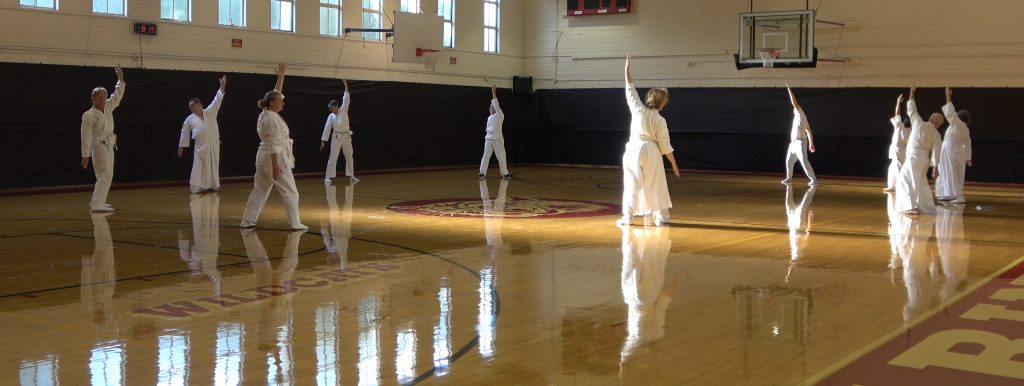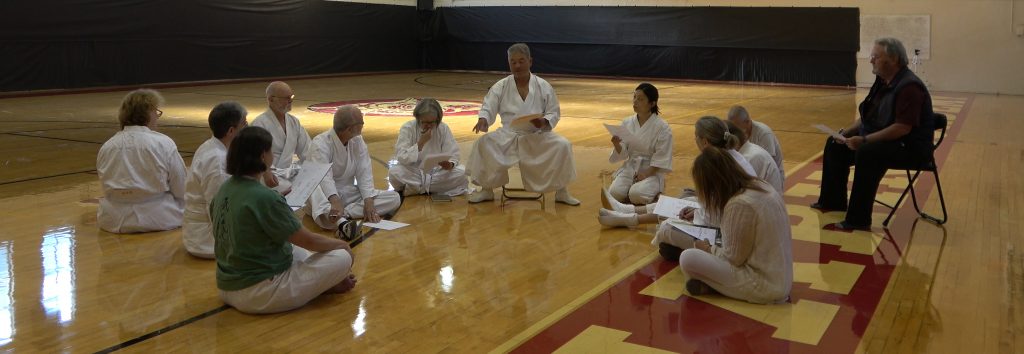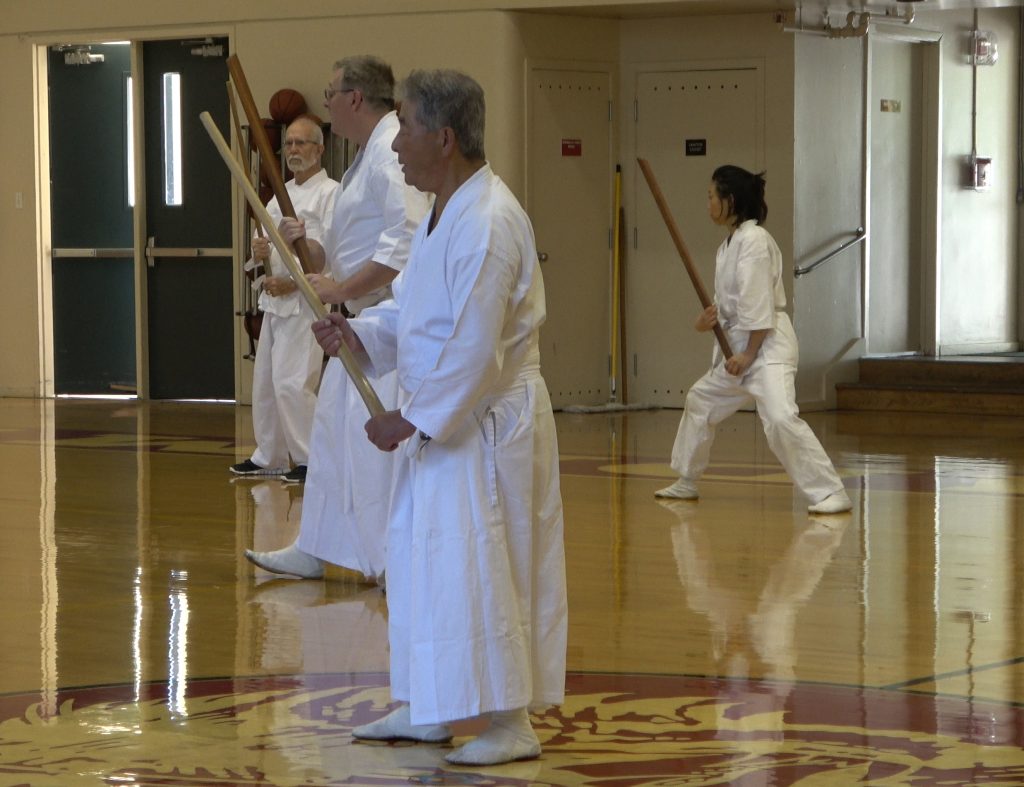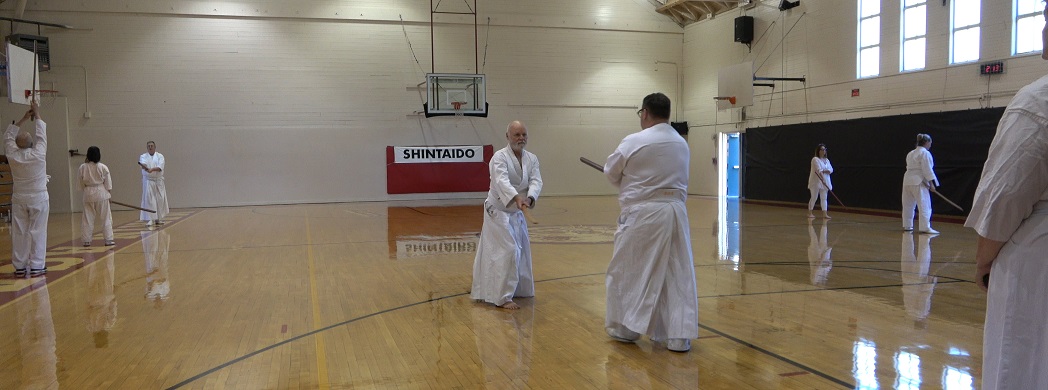By Derk Richardson and Connie Borden
On Saturday, August 17, at Marin Academy in San Rafael, California, Master Instructor H.F. Ito led Bay Area and visiting Shintaido practitioners—12 in the morning session, 10 in the afternoon—through two keiko based on the theme “Opening the Door of Perception: Muso-Ken.” Given his intention to cut back on transatlantic travel from his home in France and to visit North America only once a year, this was possibly Ito Sensei’s last summer workshop in Northern California. For some of us, that fact added a subtly poignant undertone to Ito Sensei’s deep and nuanced teaching. Throughout the day, Sarah Baker and John Bevis documented the workshop on video.
Keiko began with a form of warm-ups that was new to many of us. Connie Borden introduced the movements based on the end of Taimyo kata part III flowing into the start of Taimyo part I.

These movements are called Hugging the Sky (ho-ten-kokyu-ho), Three Quarters turn (hokushin kokyu-ho), oodachi zanshin, and kan ki. They focused on breathing (kokyu) while having us rotating, spiraling, and twisting our spine and our being to reach higher into the heavens and lower into the center of earth. We studied contrasts of creating a small circle below ourselves then opening diagonally to draw a big circle and embrace the sky. As we bowed, we studied compressing the air and space in front of us. To start hokushin kokyu-ho, we hugged a tree in front of us and then slowly expanded ourselves upward and downward, experiencing the contrast between up and down while elongating our beings, continuing our focus on deep and slow breathing. Our front hand reached up with the fingers and palm facing back, while the lower hand pointed down and three-quarters behind ourselves with the palm facing inwards.
Throughout these movements we practiced having our eyes follow our movements, ultimately having our eye movement help us go further into space and across time. In the last segment, we opened to Ten with kaisho-ken hands to the sky and then formed a tight tsuki to grasp what was waiting for us, then crossing our arms in front of ourselves we ended in the classic karate stance, kaiho-tai. With kan ki as the opening of Taimyo part I, we reached out in front of ourselves as if to dive out into the ocean of ki, and after making one last big circle around ourselves, we let ki energy land in our outstretched, wide-open palms and made a tight tsuki. We pulled our tsuki back to our sides, letting our elbows point behind ourselves while deepening into kiba-dachi (horse-riding stance). After holding this stance for a moment to allow our bodies to feel warmed, we stood in seiritsu-tai, letting our arms move downwards to our sides with our fingers actively pointed downwards. From the warmups of breathing, twisting, spiraling, and elongating, we ended feeling straight and clear, hopefully ready to study awareness of ourselves and increase understanding of others.
Before we began physical practice, we sat in a circle and Ito Sensei gave a free-flowing talk based on a double-sided handout. With Tomi Nagai-Rothe and Nao Kobayashi assisting with translation, he first discussed the various forms of ki (energy or, in French, esprit), ranging from lack of confidence/fearfulness (yowa-ki) to being resolute and ready (tsuyo-ki) or easy going (non-ki), from taking care of your own energy (ki wo tutete) to being considerate of and attentive to others (ki-kubari), and more.

The thorny concept of sak-ki, which translated to “bloodthirstiness” or “the intention to kill,” was pivotal because it related closely to the second area of discussion, muso-ken. In our practice, we would be working on developing sensitivity to energy behind us, specifically the intention and approach of someone attacking us from behind. Mu-so, Ito Sensei explained, can be taken to mean “dream,” “vision,” “premonition,” and “clairvoyance,” on the one hand, or “no phase,” “no phenomenon,” and “emptiness,” on the other, akin to the complete absence of light or dark matter.
Muso-ken, then, can be thought of as employing the sword of perception, the English definition given by French Shintaido General Instructor Pierre Quettier. And the physical practice of the morning and afternoon was dedicated to learning how to use this sword effectively.
We began with partner wakame, the initiator using a lighter and lighter touch at a quickening pace, and the receiver developing a more and more refined sensitivity to the contact and the direction of the energy through the body. Ito Sensei emphasized that wakame is something that you can never assume to have perfected, something to work on for the rest of your life—in relationships, in the family, at work, and out in the world.
The core of the practice was developing sensitivity with our backs, making our entire backside a sensor (or an array of sensors), like radar, detecting and becoming aware of what’s coming at us from behind. As we cultivated sensitivity to someone approaching from behind, we worked on two different stepping patterns to receive the attack. One involved stepping forward and slightly out (with the right foot, for instance), opening a path for the attacker by pivoting and drawing the left foot slightly aside and “welcoming” her to enter and pass with a Tenshingoso “E” motion with the left hand. The second stepping pattern involved stepping back and slightly behind (with the right foot, for instance), again opening a path by pivoting that leaves room, but not too much, for the attacker to pass, and again welcoming and urging the partner forward with a right-hand “E” motion. Both techniques are ways of managing space and time. Although Ito Sensei did not talk much about it, receivers were encouraged to be aware of and experiment with A, B, and C timing on the early-to-late-response spectrum.
After working on the stepping, the receivers took up weapons—a rolled magazine playing the part of a short stick, and then either a boken or bokuto—and added gedan bari and ha-so movements to their receiving.
As for the attackers, they approached their receiving kumite partners from behind with different techniques (and weapons), as well: using the first movements of the Diamond Eight Cut kata and stepping forward with a spearing motion; using a rolled up magazine as a short stick; and using a boken or bokuto. During the afternoon keiko, Ito Sensei had us receive dai jodan sword attacks from behind, eventually receiving two attackers so that we could gauge and deal with their different energies. Between sessions, we retreated to the home of Jim and Toni Sterling for a potluck brunch that became a continuation of keiko through social communion and philosophical discussion.

Toward the end of the afternoon keiko, Ito Sensei talked a bit about Tenshingoso in metaphorical terms, likening the patterned movements to a constant turning inside out, as we might do with socks; extending ourselves to the other side of the earth and beyond the boundaries of the universe; holding our planet with loving kindness and bringing it inside ourselves. Finally, he charged us with solo “homework” practice of the Muso-Ken movements he had taught us, and reminded us that we need to apply our Shintaido practice in general to the way we think about life and death, and the way we live our lives in the world.




Thank you Derk
Thank you, Connie!
Great writeup, thank you Derk and Connie! (Would be great to document more of our keikos this way)…
Thank you Connie. Makes me feel that I should have stayed longer.
Very beautifull document, plus Taimyo is one of my favourite practice.
Missing you “guys” (I am becoming Californian, using your terms).
Love to you Connie, Derk, Ito Sensei, Nao, Tomi and all of you,
Nicole
Thanks for this thorough, detailed article. I wish I could have been there! Connie, I added the Taimyo bits of the warm-ups described to my own practice this morning–I like the sequence from Part III to Part I. And I envy you all the discussion of the various forms of ki & the meanings of mu-so. This will bear re-reading.
Love from the Northwest–
Paula